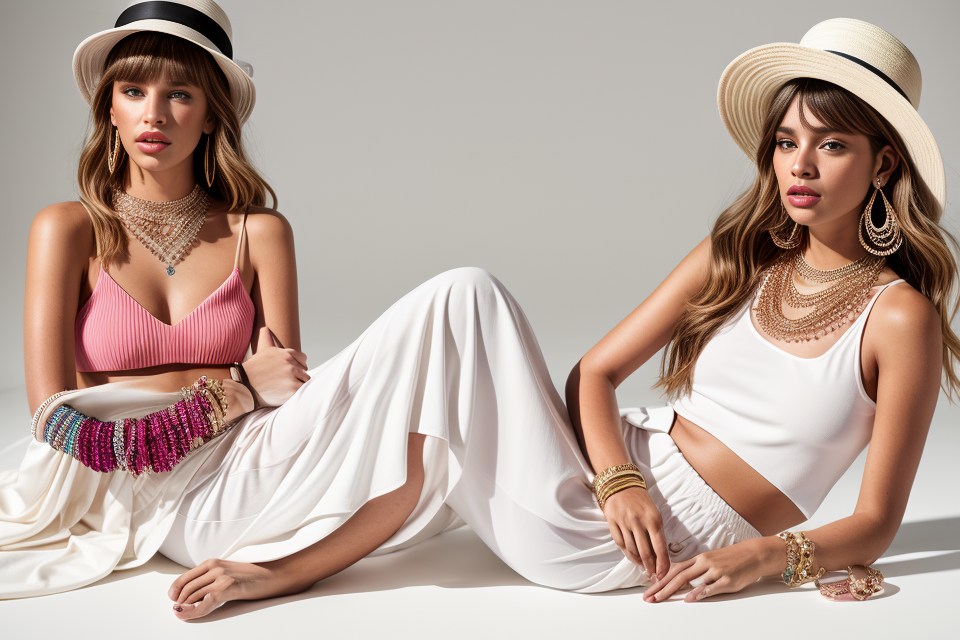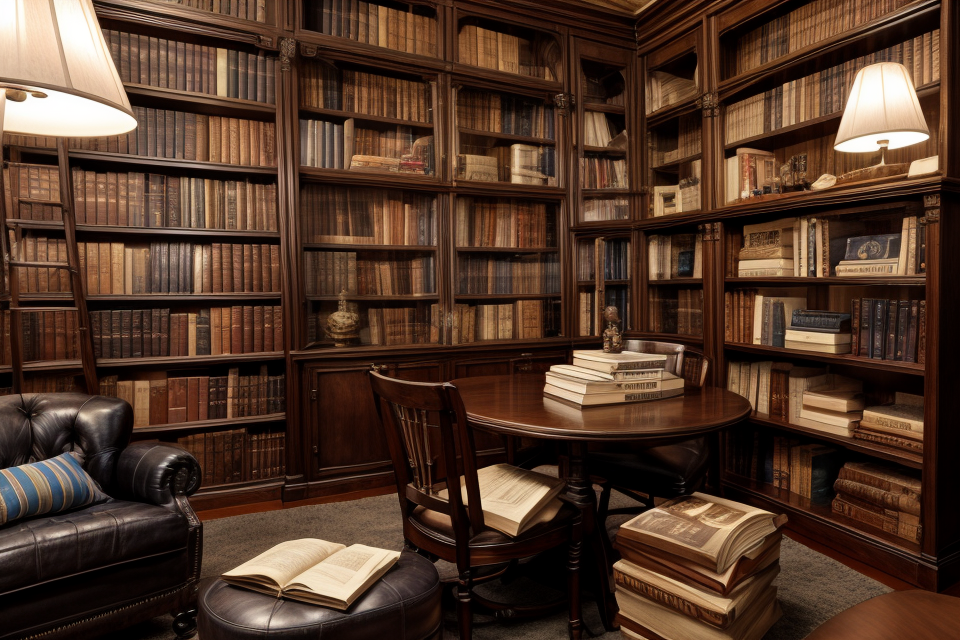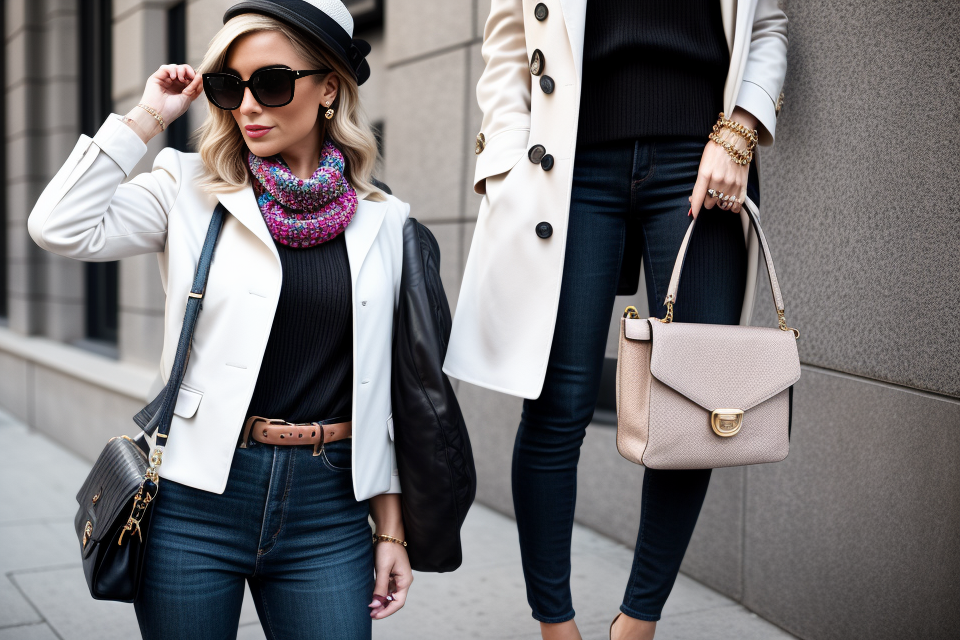
Jewellery is often seen as a mere accessory, something that adds a touch of glamour to an outfit. But is it just that? In this article, we will explore the idea that jewellery is more than just an accessory. We will delve into the history and cultural significance of jewellery, and how it has been used as a form of expression and communication throughout the ages. We will also examine the emotional connection that many people have with their jewellery, and how it can hold personal meaning and value beyond its aesthetic appeal. So, join us as we challenge the notion that jewellery is just an accessory, and discover the depth and complexity of this fascinating subject.
Yes, jewellery is more than just an accessory. It has been a part of human culture and history for thousands of years, serving not only as a decorative item but also as a symbol of status, wealth, and power. Jewellery has been used as a form of currency, a means of storing value, and as a symbol of love and commitment in relationships. It also holds emotional and sentimental value, as it can be passed down through generations as a family heirloom. Additionally, jewellery can be a reflection of personal style and individuality, allowing people to express themselves and make a statement.
What is an Accessory?
Definition and Purpose
In the world of fashion, accessories are items that are used to complement and enhance an outfit. They can include jewellery, handbags, hats, scarves, belts, and other small decorative items. The purpose of accessories is to add a finishing touch to an outfit, and to help individuals express their personal style and individuality.
Accessories can play a crucial role in defining an outfit and making it stand out. They can add a pop of colour, draw attention to a particular feature, or create a cohesive look. For example, a statement necklace can be the focal point of an outfit, while a pair of earrings can add a touch of elegance. Accessories can also be used to convey a message or express a mood, such as a black leather jacket with metal studs that conveys a tough and rebellious attitude.
Moreover, accessories are not just aesthetic additions, but they also serve practical purposes. For instance, a handbag is used to carry personal items, while a belt can hold up a pair of pants. Accessories can also be used to convey social status, cultural identity, or personal values. For example, a watch can be a symbol of sophistication and wealth, while a pair of sunglasses can be a statement of coolness and style.
Overall, accessories are an essential part of fashion and can play a significant role in enhancing personal style and expressing individuality. Whether it’s a statement necklace or a simple pair of earrings, accessories can elevate an outfit and make it stand out.
Types of Accessories
When discussing accessories, it is important to note that they are secondary elements that are added to an outfit or ensemble to enhance its overall appearance. There are several types of accessories that can be categorized based on their purpose and function.
- Clothing accessories are items that are worn on or with clothing to add a decorative touch. Examples include scarves, hats, belts, and ties. These accessories can be used to add color, texture, or style to an outfit, and can be worn with both casual and formal attire.
- Footwear accessories are items that are worn on or with shoes to enhance their appearance or functionality. Examples include socks, shoes, and sandals. These accessories can be used to add comfort, support, or style to footwear, and can be worn with both casual and formal shoes.
- Jewellery accessories are items that are worn as adornments for personal adornment. Examples include necklaces, bracelets, earrings, and rings. These accessories can be made from various materials such as gold, silver, diamonds, and gemstones, and can be worn with both casual and formal attire. Jewellery accessories are often passed down from generation to generation and hold sentimental value.
Overall, accessories play a crucial role in enhancing the overall appearance of an outfit, and can be used to add color, texture, style, comfort, support, and personal adornment.
The Significance of Jewellery
Cultural and Historical Significance
Jewellery has been a part of human culture for thousands of years, serving not only as an accessory but also as a symbol of status, wealth, and cultural identity. Throughout history, jewellery has played a significant role in various cultures and societies, reflecting the values, beliefs, and customs of different communities.
Jewellery as a form of adornment and status symbol
In many cultures, jewellery has been used as a means of adornment and a symbol of status and wealth. From ancient civilizations to modern times, individuals have worn jewellery to showcase their social standing, power, and prosperity. This is particularly evident in the use of elaborate and expensive jewellery by royalty and the elite, who sought to display their wealth and prestige through their accessories.
Cultural practices and beliefs surrounding jewellery
Jewellery also holds significant cultural and religious importance in many societies. For example, in some cultures, certain types of jewellery are worn during religious ceremonies or as part of traditional wedding attire. In other cultures, jewellery may be used to ward off evil spirits or to bring good luck and protection.
Moreover, jewellery has often been used as a means of expressing cultural identity and heritage. Ethnic groups and communities may have their unique styles of jewellery, which reflect their history, traditions, and beliefs. For instance, some communities may have specific jewellery designs that are passed down from generation to generation, serving as a connection to their cultural roots.
Furthermore, jewellery has also been used as a form of communication and social expression. In some cultures, certain types of jewellery may be worn to signify a particular status or achievement, such as a graduation or a military rank. Additionally, jewellery can be used to express personal preferences, tastes, and fashion sense, serving as a form of self-expression and creativity.
Overall, the cultural and historical significance of jewellery cannot be overstated. It is not merely an accessory but a reflection of human culture, identity, and history. Throughout the ages, jewellery has played a vital role in shaping societies and reflecting the values and beliefs of different communities.
Personal and Emotional Significance
- Sentimental value of jewellery
- Jewellery often holds sentimental value due to its ability to withstand the test of time and retain memories.
- It can serve as a symbol of love, commitment, and special moments in one’s life.
- Family heirlooms, passed down through generations, hold immense sentimental value.
- These pieces serve as a connection to one’s heritage and provide a sense of continuity.
- Emotional attachment to jewellery pieces
- Jewellery can evoke strong emotions and memories in individuals.
- Each piece can represent a specific moment or event in one’s life.
- The sentimental value of jewellery can provide comfort and solace during difficult times.
- The emotional attachment to jewellery pieces can vary from person to person, based on personal experiences and emotions.
- For some, it may represent a symbol of hope, courage, or strength.
- For others, it may serve as a reminder of a loved one or a special memory.
- The emotional attachment to jewellery pieces can create a deep connection between the individual and the piece, making it a cherished possession.
Versatility and Functionality
Jewellery serves not only as a fashion accessory but also as a form of personal expression and cultural symbolism. It has been worn by individuals throughout history for various purposes, from displaying wealth and social status to showcasing artistic and creative talents. The versatility and functionality of jewellery make it a timeless and versatile addition to any wardrobe.
- Diverse uses of jewellery
- Statement pieces: Jewellery can be used to make a bold fashion statement, drawing attention to a particular outfit or aspect of one’s appearance.
- Special occasions: Certain types of jewellery, such as engagement rings or formal necklaces, are often reserved for special occasions and hold sentimental value.
- Practicality of jewellery as an accessory
- Durability: Jewellery is often made from durable materials, such as precious metals and gemstones, ensuring that it can withstand daily wear and tear.
- Versatility: Jewellery can be layered, mixed, and matched with different outfits and styles, making it a versatile accessory that can be worn in a variety of settings.
- Functionality: Jewellery can serve practical purposes, such as keeping track of time with a watch or serving as a fashionable phone accessory with a pendant or earbud holder.
These aspects of versatility and functionality highlight the significance of jewellery as a valuable and meaningful accessory that goes beyond mere adornment.
Beyond the Accessory: The Art of Jewellery
Craftsmanship and Techniques
Jewellery-making is an art form that requires a great deal of skill and expertise. The craftsmanship and techniques involved in creating jewellery are a testament to the dedication and passion of the artisans who create these beautiful pieces.
There are many different jewellery-making techniques and materials used in the industry, each with its own unique characteristics and properties. From traditional techniques like wire wrapping and soldering to modern methods like 3D printing and laser cutting, the possibilities for creating jewellery are virtually endless.
One of the most important aspects of jewellery-making is the selection of materials. Different materials have different properties that can affect the look, feel, and durability of the final piece. For example, precious metals like gold and silver are highly sought after for their beauty and durability, while semi-precious stones like amber and jade are prized for their unique colors and textures.
In addition to the materials used, the craftsmanship and techniques employed in jewellery-making can also greatly affect the final product. For example, the intricate details and patterns of filigree or enamel work can add a level of complexity and beauty to a piece, while the use of granulation or beadwork can create unique textures and designs.
Overall, the craftsmanship and techniques involved in creating jewellery are what set it apart from other accessories. While some may view jewellery as simply a decorative item, those in the industry know that it is much more than that. It is a form of art that requires skill, creativity, and dedication, and the final product is a testament to the passion and talent of the artisans who create it.
Design and Aesthetics
The artistic value of jewellery design
Jewellery design is an art form that transcends the boundaries of functionality and fashion. Each piece is a unique creation that tells a story, evokes emotion, and connects the wearer to their personal history and cultural heritage.
The artistic value of jewellery lies in its ability to combine aesthetics, craftsmanship, and materials to create a piece that is both visually stunning and emotionally resonant. From the intricate filigree of antique gold jewellery to the bold and geometric lines of modernist designs, jewellery reflects the creativity and skill of its makers.
Moreover, jewellery can also be a platform for social and political commentary. For example, artist-jewellers like Barbara Hepworth and Wendi Corsi Staub have used jewellery to explore themes of identity, power, and gender. Their work challenges traditional notions of what jewellery is and can be, and pushes the boundaries of what it means to be an artist working in this medium.
The influence of fashion and trends on jewellery design
Jewellery design is not only an art form but also a reflection of the fashion and cultural trends of its time. Throughout history, jewellery has been influenced by the social, political, and economic conditions of the era.
For instance, during the Victorian era, the fashion for ornate and elaborate jewellery reflected the social and economic prosperity of the time. In contrast, the Art Deco movement of the 1920s and 1930s was characterised by bold geometric shapes and bright colours, which were inspired by the modernity and optimism of the era.
Today, jewellery design continues to be influenced by fashion and trends. Designers draw inspiration from a range of sources, including art, architecture, and nature, to create unique and innovative pieces that reflect the zeitgeist of the moment. The influence of fashion and trends on jewellery design ensures that it remains a dynamic and constantly evolving art form.
Investment and Collectibility
While jewellery is often viewed as an accessory to enhance one’s appearance, it can also be considered a form of art and an investment opportunity. The value of certain jewellery pieces can appreciate over time, making them a wise financial decision for collectors and investors.
One factor contributing to the investment potential of jewellery is its limited supply. Unlike mass-produced items, many jewellery pieces are unique and crafted by skilled artisans. This rarity and craftsmanship can contribute to the value of the piece, making it a desirable investment for collectors.
In addition to limited supply, the quality and craftsmanship of the jewellery can also impact its value. High-quality materials, intricate designs, and exceptional workmanship can increase the value of a piece, making it a valuable investment. Furthermore, jewellery that has historical or cultural significance can also appreciate in value over time.
The collectibility of jewellery is another factor that contributes to its investment potential. Similar to art, certain jewellery pieces can become highly sought after by collectors, driving up their value. The rarity, quality, and cultural significance of a piece can all contribute to its collectibility.
In conclusion, jewellery can be considered more than just an accessory. Its potential as a form of art and investment opportunity make it a valuable asset for collectors and investors. Whether it’s the limited supply, quality, or cultural significance of a piece, jewellery can appreciate in value over time, making it a wise investment decision.
The Jewellery Accessory: More Than Just an Add-On
Enhancing Personal Style
Jewellery is often viewed as an accessory, an item to be added to an outfit to enhance its appearance. However, it is much more than that. Jewellery has the power to complement and elevate an outfit, adding a touch of glamour and sophistication to even the most basic of outfits. It can also make a statement, adding personality and individuality to an outfit.
Jewellery has the ability to enhance personal style in many ways. It can be used to make a statement, add a pop of color to an outfit, or simply add a touch of elegance. When worn with confidence, jewellery can make a person feel more confident and stylish.
- Complementing and Elevating an Outfit
Jewellery can be used to complement an outfit, adding a touch of glamour and sophistication. For example, a simple necklace can elevate a plain t-shirt and jeans outfit, adding a touch of elegance. Similarly, a pair of earrings can add a pop of color to a monochromatic outfit, making it more interesting and eye-catching. - Making a Statement
Jewellery can also be used to make a statement, adding personality and individuality to an outfit. For example, a bold bracelet or necklace can add a touch of edge to a feminine outfit, making it more interesting and unique. Similarly, a statement earring can add a pop of personality to a simple outfit, making it more memorable. - Adding a Touch of Elegance
Jewellery can also be used to add a touch of elegance to an outfit. For example, a classic pair of pearl earrings can add a touch of sophistication to a casual outfit, making it more polished and put-together. Similarly, a delicate necklace can add a touch of grace to a formal outfit, making it more elegant and refined.
In conclusion, jewellery is much more than just an accessory. It has the power to complement and elevate an outfit, adding a touch of glamour and sophistication. It can also make a statement, adding personality and individuality to an outfit. When worn with confidence, jewellery can make a person feel more confident and stylish.
Statement-Making
- The power of jewellery as a means of self-expression
- Adornment as a reflection of personal taste and style
- Cultural significance and meaning behind specific jewellery pieces
- Intricate craftsmanship and symbolism in traditional jewellery
- The influence of jewellery on personal branding and identity
- Accessorizing as a tool for self-discovery and reinvention
- Jewellery as a means to communicate one’s values and beliefs
- The impact of statement pieces on perception and memory.
Timelessness and Universal Appeal
- The enduring appeal of jewellery across cultures and generations
Jewellery has been a staple of human adornment for thousands of years, transcending time and cultural boundaries. Its allure has been a constant, even as civilizations have risen and fallen, and fashion trends have come and gone.
This timelessness is, in part, due to the emotional and sentimental value that jewellery holds for individuals. From engagement rings to family heirlooms, jewellery often represents significant life events, relationships, and personal history. As such, it is passed down from generation to generation, retaining its significance and meaning long after the passing of time.
- The ability of jewellery to transcend fleeting fashion trends
While fashion trends may come and go, the essence of good design in jewellery remains constant. It is this inherent beauty and craftsmanship that has allowed certain pieces to remain relevant and sought after, even centuries after they were first created.
Furthermore, the versatility of jewellery allows it to be adapted to changing fashion trends while still maintaining its core aesthetic. A classic necklace, for example, can be worn with a modern, minimalist outfit just as easily as it can with a more ornate, traditional ensemble.
In this way, jewellery is not merely an accessory, but a representation of personal style and individuality. It is a reflection of one’s own history and experiences, as well as a means of expressing one’s self in the present.
FAQs
1. What is jewellery?
Jewellery is a decorative item worn for personal adornment, such as necklaces, bracelets, rings, earrings, and brooches. It can be made from various materials like gold, silver, diamonds, gemstones, and other precious or semi-precious materials.
2. Why do people wear jewellery?
People wear jewellery for various reasons, including personal expression, cultural or religious beliefs, sentimental value, or as a fashion statement. Jewellery can also symbolize status, wealth, and power, and has been used as a form of currency throughout history.
3. Is jewellery just an accessory?
While jewellery can be considered an accessory, it is more than just a decorative item. It has been an integral part of human culture and history for thousands of years, and holds significant value beyond its aesthetic appeal. From ancient civilizations to modern times, jewellery has been used for various purposes, such as personal adornment, ritual, and social status symbolism.
4. What makes jewellery more than just an accessory?
Jewellery is more than just an accessory because it has a deep cultural and historical significance. It has been used as a form of art, symbol, and expression of identity for generations. Each piece of jewellery has a story to tell, whether it’s a family heirloom passed down through generations or a contemporary design that reflects current trends. Additionally, jewellery can be a symbol of love, commitment, and sentimental value, making it more than just a superficial decoration.
5. What are some examples of jewellery being more than just an accessory?
There are many examples of jewellery being more than just an accessory. For instance, wedding rings symbolize love and commitment, and are often passed down as family heirlooms. Earrings, necklaces, and bracelets can also hold sentimental value, as they can be personal gifts or reminders of special moments or people in our lives. Additionally, cultural and religious jewellery, such as crosses, stars of David, or hijab pins, hold deep spiritual and cultural significance beyond their aesthetic appeal.


